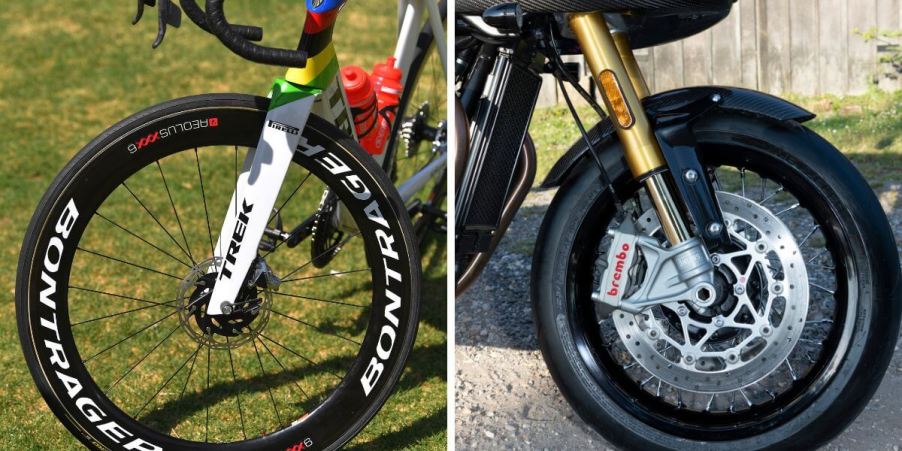
Bike Brakes vs. Motorcycle Brakes: How to Halt Your Handlebars
Bicycles and motorcycles have many apparent differences but also a few similarities. Naturally, they both require braking systems to function correctly. Some details are unique to bicycle and motorcycle brakes, but they also have some things in common. Here’s a look at how the braking systems of bikes and motorcycles compare.
Bicycle braking systems
Rim brakes
One of the most common types of bicycle braking systems is rim brakes. As its name implies, rim brakes work via a caliper squeezing the bike’s rim to slow it down. According to Bike Rader, the caliper uses brake pads like a disc brake system on a car or motorcycle, but rather than squeezing a brake rotor, force is applied directly to the wheels.
This system has its advantages. It’s a relatively simple cable-driven system with lightweight, low-cost components. Besides keeping the pads and cables fresh, this system requires little to no maintenance.
A similar V-brake (or direct-pull cantilever brake) system also applies pressure directly to the rims. The difference is that it’s a side-actuated braking system with two arms connected via a “noodle” to apply the brake pressure. However, this system is becoming less common as disc brakes get more popular on mountain bikes.
Disc brakes
That brings us to disc brakes, a modern braking system commonly found on mountain bikes and premium bicycles. A disc brake system on a bicycle is not too different from a disc brake system on a motorcycle. A caliper is mounted to the frame, and a rotor is mounted to the wheel. When activated, the caliper squeezes the brake rotor to slow down the bike. A disc brake system has many advantages like even, predictable braking force and good wet performance, making it an ideal system for mountain bikes.
Some disc braking systems are cable-driven, while more high-end bikes use a hydraulic brake system similar to a motorcycle. While a hydraulic system delivers better braking performance, a cable system is cheaper, lower maintenance, and easier to fix in a pinch.
Compared to rim brakes on a bicycle, the disadvantages of disc brakes are higher cost and more maintenance, especially with a hydraulic system. However, for most serious bicyclists, the pros outweigh the cons with disc brakes.
Motorcycle braking systems
Disc brakes
The vast majority of modern motorcycles use a hydraulic disc brake system, according to Family Handyman. This is not so different from disc brakes on a car. Brake calipers equipped with brake pads squeeze the brake calipers to slow down the bike. High-performance bikes often have dual-disc front brakes with ventilated rotors for better stopping power and reduced risk of overheating.
That’s not to say disc brakes on a motorcycle are the same as disc brakes on a bicycle. For starters, motorcycles don’t use cable-driven braking systems like many bicycles do. Also, modern motorcycles have more sophisticated braking technology, namely antilock brake systems, improving safety and performance.
Drum brakes
It’s not uncommon for older motorcycles to have a drum rear brake and a disc front brake. Drum brakes are a little more primitive and add more weight to the bike, but they used to be common because they were cheaper. These use cable-driven brake shoes inside a brake drum to slow down the wheel. Drum brakes are uncommon on modern motorcycles.
Differences and similarities
The similarities in braking systems between bicycles and motorcycles are most apparent when a bike is equipped with a hydraulic disc brake system. The components still differ due to the fundamental differences between the two vehicles. However, the basics are the same.
The most significant differences in braking systems between the two are that motorcycles don’t use rim brakes, and bicycles don’t have advanced technologies like ABS.



